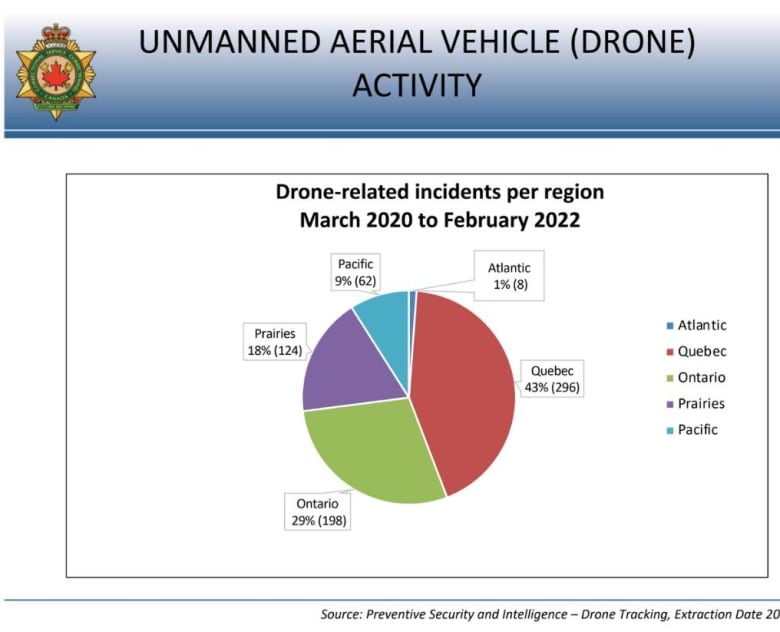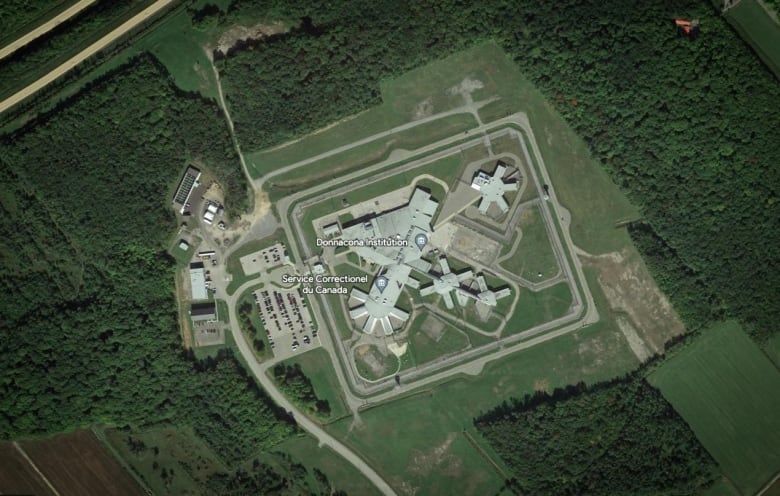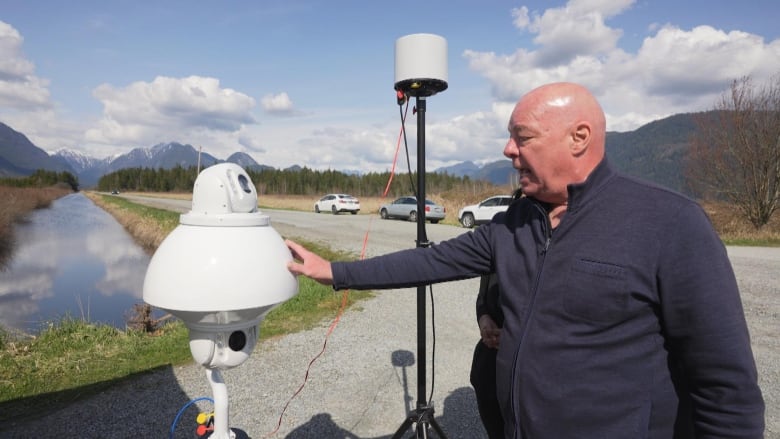Drug-smuggling drones rampant in Canadian prisons, says correctional officers' union
Bundles of drugs and other illegal items have been dropping into prison yards across Canada

Layers of barbed wire fencing surround the Matsqui Institution in Abbotsford, B.C. The massive, concrete prisonsits among rural fields across from an elementary school, about 70 kilometres east of Vancouver.
Despite the fortification, the union representing correctional officers says bundles of drugs have literally and routinely been dropping from the skies into prisonyards like this across Canada.
Last fall, a drone dropped a batch of toxic drugs that contained fentanyl into the B.C. prison. One inmate died, and nine others who overdosed were taken to emergency, according to the Union for Canadian Correctional Officers (UCCO). Another 39 required medical intervention.
Drones are also delivering reams of steroids, cellphones and weapons such as ceramic knives and hacksaw blades, says John Randle, the regional president of the UCCOfor B.C.
"It's absolutely insane."
In some instances, he said, drones are flying right up to an inmate's window to deliver drugs, similar to a takeout window for fast food.
In prisons across Canada from Atlantic Canada to the West Coast the union saysdrone drops are a daily occurrence. It says the contraband has led to increased violence and overdoses in prisons and burdened inmates with large debts.
Right now, about 75 per cent of contraband seizures are attributed to drone drops, according to Randle.

Canadian prisons aren't alone in dealing with drones.
In an audit released in 2020, the U.S. Department of Justicesays the number of reported drone incidents in American prisons had increased by over 50 per cent.
As smugglers get creative, prison authorities are grappling with the phenomenon, and they are looking for new technology to help.
Correctional Service Canada(CSC) says it's aware of the drone problem and is working with companies to find national solutions. In 2019, it announced it would spend $6 million to install radar-based drone detection equipment in six Canadian prisons. The goal was to have them operational by March 2022, but the union says that hasn't happened.
On a sunny day in April of this year, Randlestood just outside the fence enclosing the Matsquimedium-security prison, holding a drone tightly wrapped in black tape with a hook attached to it.
It had crashed just outside the prison. Randle believes it was making a delivery to the prison, although no contraband was found near it.
Concerns of overdoses, violenceand debt
The deliveries can be tightly wrapped in plastic and dangle from hooks or boxes. The black tape secures the package and conceals the drones' blinking lights at night, Randle says.

He pulls out his cellphone and shows a photo of a brazen drone drop in 2022 at the Matsqui Institution. Officers found 13 individually wrapped packages of crystal meth, which had a street value estimated at $7,800 but which Randle says was worth about $180,000 in prison.
On average, he says the value of drugs can be worth 10 times more in prison compared to the streets, largelybecause the supply of drugs in prisons is restricted while the demand is high.
Between March 2020 and February 2022, there were almost 700 drone-related incidents in Canadian prisons, according to a CSCchart provided by the union. Quebec has the highest percentage of drone incidents.
Statistics of drone-related incidents in prisons werenot directlyprovided by CSC to CBCNews. The federal agencysays sharing that informationcreates security vulnerabilities for staff and offenders.
"It could also allow criminal networks to further attempt to introduce contraband," it said in a statement.

Correctional ServiceCanada says it prevents contraband from entering prisons in numerous ways, includingsearching offenders, visitorsand staff, sometimes with drug-detectingdogs. There are also ion-canningdevices which detect trace amounts of drugs in the lobbies and mail rooms of some of the prisons.
"Protecting the safety and security of our institutions is a top priority for the Correctional Service of Canada, " the agency said in astatement.
'Huge delay'in drone detection technology, union says
Back in Abbotsford, Randle says guards try to keep an eye on the skies as drones buzz above, but prisons don't have the resources to keep up with them.
DespiteCSC'sannouncement to have drone-detecting technology operational by last year, the unionsays work is currently underway to test and install drone-detecting technology at only one prison in Quebec, the Donnacona Institution, which the union says can see two to three drone drops a day.
The technology is still being tested and is not yet available in other prisons, said Frederick Lebeau, the national vice president of UCCO.
"Huge delay for sure," said Lebeau.
"Sometimes, it takes time to do the procurement. It takes time to install them.But at least they need to make a strong commitment, and they need to assure that us officers, the civilians, even the inmates are safe inside the institution. It's crucial for us."

Correctional Service Canadadid not agree to an interview. Despite repeated requests, it declined todivulge how many prisons have access to the technology since the program was announced, citing security concerns.It also did notexplain what kind of specific drone detection technology it is researching.
In a statement, the federal agency saidit is working with companies developing technologies to detect drones. Once they're up and running in prisons, it said it wouldconsider expanding them to more prisons.
B.C. company providingdrone detection tech to U.S.
Bluvec Technologies Inc, a Burnaby-based drone detection company that has pitched its technology to CSC and is waiting for feedback on its offer, saysits tech is used in 20 U.S. prisons.
Manager Thomas Barter says the company has developed software to detect the radio frequency signals of a drone up to a 24-kilometreradius. Thetechnology with basic sensors starts at $50,000.

In a demo of the equipment provided to CBC Newsin Pitt Meadows, about 35kilometres west of Abbotsford, a drone circled above farmland,the detection machine sounding an alarm as it tracked the drone and the pilot's route.
"The software is the secret sauce," said Barter ofsomething he hopes to soon install in Canadian prisons.
Randle says as drones get more advanced and carry more weight, it becomes a scarier situation inside prison walls.
"This job, in itself, isbecoming increasingly dangerous. We need the tools to start detecting these drones and start stopping these drones."













_(720p).jpg)


 OFFICIAL HD MUSIC VIDEO.jpg)
.jpg)



























































































